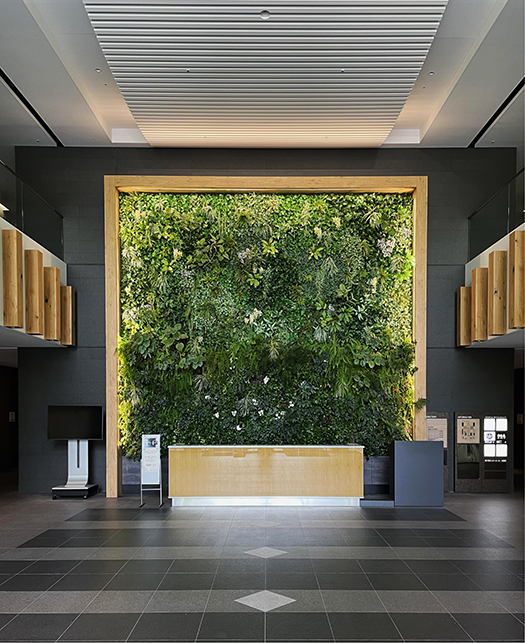
先日の東京ビッグサイトでのAIイベント出張時、都内と会場との往復移動でどうしたらいいかと考えた結果、はじめて「新木場駅」を経由することにした。ちょうど会場往復後の訪問先のことを考慮してクルマを借りていたので、新木場駅周辺での駐車場に入庫後、往復に出掛けた。
で、駐車場が地下だったのでいったん1階に上がって駅に向かおうとしたら、上の写真のようなフロントディスプレイに遭遇した。一見して、皇居のような巨大な森が窓越しに見えるかと錯覚した。
しかしよく見ると、これは木製の額縁で仕切って壁面緑化手法で自然の植物なのだと気付かされた。その生命感が新鮮で、単に自然から切り取って貼り付けました,という様子ではない。しっかりとこの体勢で「根付いて」いて、その状態で新鮮な発芽があり枝葉が生育しているのだと望見できた。
壁面緑化という手法によってコンクリートで固めた現代建築が醸し出す空気感に「うるおい」を与えようという試みをよく見聞きしていたけれど、それは一定の自然光受容があって成立すると思っていた。それに対してこれはものすごく「自然」に馴染んでいるのだけれど、どう考えても室内なのでよく考えると「不思議」感はあった。
そう考えてさらによく見てみると、どうも採用されている植物群は玄関のガラス面からの微弱な太陽光でもそれなりに生育可能なものなのかも知れないと想像できた。
壁面緑化というのは、東京のような極度密集地域では面積を必要としないで自然を復元させていくためのひとつの「解」でもあると思うので、こういった試みは大変有意義だと思った次第。少なくともわたしのようなエトランゼにも、強い好感として伝わった。

このビルを出てみたら、今度はとなりのビルではこんな試みも行われていた。木質建材によるコンクリート建築への「付加」外皮の様子。機能としては日射遮蔽のひとつの手法なのだろうと思える。コンクリートだけが外皮を構成するのと比べると、やはり人間の目にうるおい感は感じさせられる。
たぶん都の防火の規定でも一定の「外壁後退」が確保されれば木質建材使用は条件クリアすることができるのだろう。
壁面緑化にせよ木質外皮にせよ、こういった試みは大いに盛り上がって欲しい。昔の江戸の街では町人街で植木鉢などの連続などのちょっとした工夫で緑の演出がされていた様子が伝えられている。最近のこういった都市緑化の挑戦は、江戸期からのDNAが復権してきているようにも感じる。
English version⬇
Woody and natural design in Shinkiba Station area
In the tenement district of Edo (1603-1867), flowerpots were lined up along the street to ensure greenery that was easy on the human eye, based on the concept of mutual aid. There is no reason why such wisdom and ingenuity cannot be applied today. …
On a recent business trip to an AI event at Tokyo Big Sight, I wondered what I should do when traveling to and from the venue in Tokyo, and decided to go via “Shinkiba Station” for the first time. I had rented a car in consideration of my destination after the event, so I parked at a parking lot around Shinkiba Station and went out for the round trip.
As the parking lot was underground, I went up to the first floor to go to the station and encountered a front display like the one in the photo above. At first glance, I was under the illusion that I could see a huge forest like the Imperial Palace through the windows.
However, upon closer inspection, I realized that these were natural plants, partitioned by wooden frames and using the wall-greening technique. The sense of life is fresh and fresh, and it does not look as if it were simply cut from nature and pasted on the wall. It was firmly “rooted” in this position, and I could see fresh germination and growth of branches and leaves in this state.
I have often seen and heard of attempts to give “moisture” to the atmosphere created by modern concrete-framed buildings through the use of wall greening, but I had thought that such attempts were only possible with a certain amount of natural light. In contrast, this work is very much in tune with “nature,” but it is indoors, so when I thought about it more closely, I felt a sense of “strangeness.
After thinking about it and looking at it more closely, I could imagine that the plant group employed might be able to grow to a certain extent even in the weak sunlight coming from the glass surface of the entrance.
I think that wall greening is one of the “solutions” to restore nature in extremely dense areas such as Tokyo without requiring a large area. At least, even for an étranger like myself, I felt a strong positive impression of the project.
When I left this building, I found that the building next to it was also experimenting with the following. This is a view of an “added” exterior skin to a concrete building using wood building materials. It seems to me that this is a method of shielding the building from the sun. Compared to a building with an exterior skin composed only of concrete, it still gives a sense of lusciousness to the human eye.
Perhaps the Tokyo Metropolitan Government’s fire prevention regulations also allow the use of wooden building materials as long as a certain amount of “exterior wall setback” is secured.
Whether it is wall greening or a wooden skin, I would like to see these kinds of attempts gain a lot of momentum. In the old days in Edo (old name for Tokyo), the streets of the townspeople’s districts were decorated with greenery through a series of flowerpots and other small efforts. I feel that these recent attempts at urban greening are restoring the DNA that has been present since the Edo period.
Posted on 5月 28th, 2023 by 三木 奎吾
Filed under: 日本社会・文化研究







コメントを投稿
「※誹謗中傷や、悪意のある書き込み、営利目的などのコメントを防ぐために、投稿された全てのコメントは一時的に保留されますのでご了承ください。」
You must be logged in to post a comment.